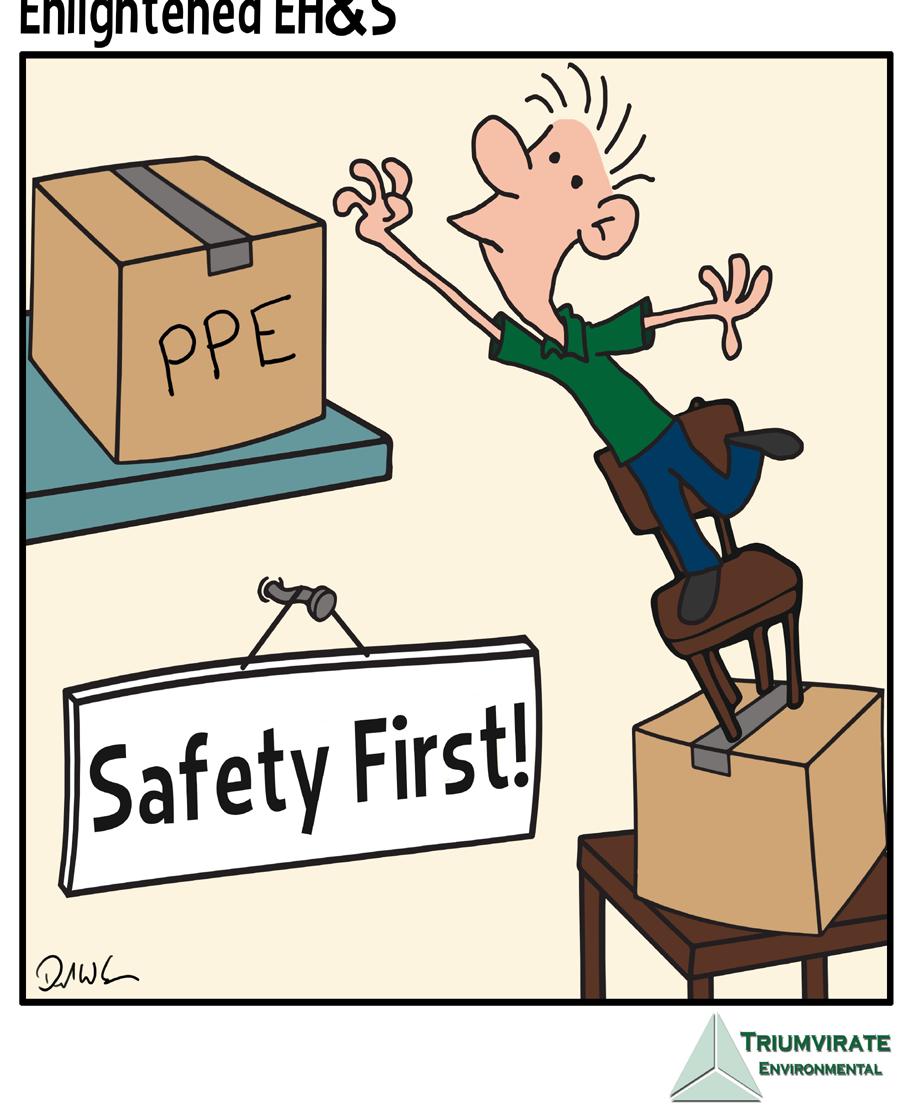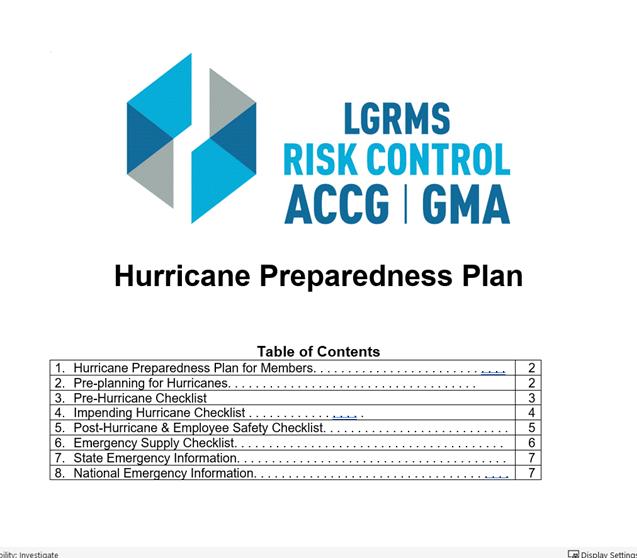
SAFETY THEME DOWNLOAD THIS MONTH’S SAFETY POSTER HEALTH PROMOTION SERVICES CHECK OUT THE LIVING WELL GEORGIA CORNER RISK/LIABILITY CHECK OUT THIS MONTH'S LIABILITY BEAT P.25 The opinions expressed in this newsletter are those of the author's and do not reflect the views of LGRMS, ACCG, or GMA. WALK AROUND Inspection LOCAL GOVERNMENT RISK MANAGEMENT SERVICES, INC. - A Service Organization of the ASSOCIATION COUNTY COMMISSIONERS OF GEORGIA and the GEORGIA MUNICIPAL ASSOCIATION Safety Health and Risk E-Connect NEWSLETTER August 2023 Issue #26 Also in this issue Investigation Steps Heavy Equipment Breakdown
Upcoming webinars and training events
workers compensation 101 Program training
Half day | 8:30Am - 12:30pm
August 15 - Cartersville, GA
contracts regional Program training
full day | 8:30Am - 3:30pm
August 16 - Cartersville, GA
August 22- Statesboro, GA
August 23 - Tifton, GA
Safety Coordinator I training
Half day | 9:00Am - 12:00pm
August 1 - Tifton, GA
August 29 - Macon, GA
September 5 - Cartersville, GA
September 12 - Gainesville, GA
Safety Coordinator II training
Half day | 12:45Am - 3:45pm
August 1 - Tifton, GA
August 29 - Macon, GA
September 5 - Cartersville, GA
September 12 - Gainesville, GA
Safety Coordinator III training
Half day | 9:00Am - 12:00pm
August 2 - Tifton, GA
August 30 - Macon, GA
September 6 - Cartersville, GA
September 13 - Gainesville, GA
Health promotion Champion training
full day | 9:00Am - 12:00pm
September 12 - Gainesville, GA
September 19- Cartersville, GA
September 21 - Macon, GA
September 26 - Tifton, GA
September 28- Statesboro, GA
LERS training
full day | 8:30Am - 3:30pm
September 5 - Bainbridge, GA
September 7 - Waycross, GA
September 12 - Jasper, GA
September 14 - Brunswick, GA
September 19 - Tifton, GA
September 21 - Forsyth, GA
September 26 - Garden City, GA
September 28 - Athens, GA
October 3 - Pine Mountain, GA
LERS summit
full day | 8:30Am - 4:30pm
November 2 - Forsyth, GA
IMPORTANT NOTE:
Dates June/July be subject to change. Please check the LGRMS website for the most current listing of training events in your area. Please visit: www.lgrms.com/trainingeventcalendar
SHARE NEWS 2 CONTENTS 3 A Note from the Editor Welcome to August 4 Director's Corner Investigation Steps 6 New LGRMS Staff Member Welcome Kaitlyn Wasner 10 Liability Beat 5th Circuit Discusses Excessive Force 16 Heavy Equipment Breakdown 18 Fun With Safety 20 Health Promotion Services Fitness Trackers 25 Safety Theme Walk Around Inspection 28 Safety Bulletin Walk Around Inspection- Poster 29 Hurricane Preparedness 30 Safety Forms General Safety Inspection Forms 33 LGRMS Contacts
3500 Parkway Lane Suite 110 Peachtree Corners, GA 30092
www.lgrms.com
Welcome to the August edition of SHARE, the monthly publication of Local Government Risk Management Services (LGRMS). SHARE is sent to all GIRMA/IRMA, WC, and Life & Health members 10 times per year.
SHARE has two sections: (1) a general safety, risk, and health section, and (2) a worker safety-focused section similar to the old Safety Theme.
We cover those topics and issues most relevant to Local Governments in Georgia, plus some new features. We look forward to your feedback. The LGRMS SHARE is published on or around the 20th of each month. If you are not currently on the distribution list to receive our monthly newsletter, it can be downloaded for free from the LGRMS website (www.lgrms.com).
In this issue
In this issue, we have a variety of articles focusing on current topics affecting local governments. Workers and worker safety is always our number one focus. As part of that, our focus is walkaround inspections. The best way to protect our workforce is to identify hazards before they become a problem. Walkaround inspections are a great way to find the hazards before they become the cause of an incident. Our on the road article from Steve Shields addresses proper hook up
of trailers when towing. Something that can easily be identified during a walkaround inspection.
Our law enforcement focus is on auditing your training. Training should be challenging and in some cases fun. Instructors enhance training with interactive activities to engage students. Make sure those activities are professional.
Dan Beck discusses Investigation strategies for comprehensive incident investigations. When incidents happen, having a plan in place to investigate, makes the job much easier.
Our online training calendar is up and running. We have just started our fall Safety Coordinator series, and are revving up for our Law Enforcement Risk Specialist Training in September. Go to www.lgrms.com and click on TRAINING EVENT CALENDAR to see what is offered and to register. For questions or issues, contact Shamilla Jordan at sjordan@lgrms.com, or Cortney Steptor at csteptor@lgrms.com.

Questions or Concerns
Should you have any questions or concerns, please contact: Dennis Watts, dwatts@lgrms.com, or Shamilla Jordan, sjordan@lgrms.com.
Director's Corner Comprehensive incident investigation: A step-by-step guide
By Dan Beck, LGRMS Director
Introduction:
Incidents can occur in various settings, ranging from workplaces and public spaces to everyday activities. When an incident occurs, it is essential to conduct a thorough investigation to understand its root cause and prevent similar incidents from happening in the future. A well-structured incident investigation not only helps in identifying the immediate causes but also sheds light on underlying systemic issues. In this article, we will discuss the critical steps required to conduct a comprehensive incident investigation.
1. Develop a Plan:
The first and perhaps most crucial step in any incident investigation is to develop a detailed plan. This plan serves as a roadmap for the investigation, ensuring that all aspects are considered. When developing the plan, the following points should be addressed:
• What Tool? Determine the appropriate investigation tools and techniques based on the nature of the incident. These may include investigation software, data analysis tools, or specialized equipment.
• What Pictures? Assess the need for visual documentation, such as photographs or videos, to reconstruct the incident scene accurately. Visual evidence can be invaluable in understanding the sequence of events.
• What People? Identify the individuals directly involved in the incident, including witnesses, victims, and any potential responsible parties. Plan how and when to interview them.
• What Experts? Depending on the complexity of the incident, consider involving subject matter experts who can provide specialized knowledge and insights. These experts may come from various disciplines, such as engineering, safety, or medical fields.

2. Collect Facts:
The second step in the investigation process involves collecting all relevant facts and evidence related to the incident. This phase requires meticulous attention to detail and thoroughness. The following actions should be taken during this step:

• Interview Witnesses: Conduct interviews with all witnesses to the incident. Their firsthand accounts can provide valuable information about what transpired and may highlight any critical observations.
• Take Measurements: In incidents involving physical locations or objects, taking accurate measurements can be essential for the investigation. This may include measurements of distances, dimensions, or environmental factors.
• Take Pictures/Video: Photographs and videos
SHARE NEWS 4
can offer a visual representation of the incident scene, injuries sustained, or property damage. Take multiple shots from various angles to ensure comprehensive documentation.
• Obtain Training, Inspection, Manuals, and Other Documentation: Gather all relevant documents, such as training records, inspection reports, operation manuals, and any other relevant material that may help understand the incident context and potential contributing factors.
3. Analyze the Information:
With the facts and evidence collected, the next step is to analyze the information thoroughly. This analytical phase involves carefully reviewing and interpreting the data to uncover patterns, causal relationships, and potential contributing factors. Key activities in this step include:
• Identify Root Cause: Determine the root cause of the incident by exploring all plausible contributing factors. Avoid jumping to conclusions and rely on evidence-based analysis to establish the true cause.
• Develop Corrective Action Plan: Once the root cause is identified, develop a comprehensive corrective action plan to address the underlying issues and prevent future incidents. The plan should be practical, feasible, and supported by stakeholders.
4. Write a Report:
The investigation report serves as a comprehensive record of the incident investigation process and its outcomes. This written document communicates the findings to relevant parties and guides future preventive measures. The report should include the following components:
• Executive Summary: Provide a concise overview of the incident, its consequences, and the key findings.
• Background and Scope: Describe the context of the incident, including the date, time, location, and parties involved. Clearly define the scope of the investigation.
• Facts and Evidence: Present a detailed account of all the facts, evidence, and witness statements collected during the investigation.
• Root Cause Analysis: Identify and explain the root cause of the incident based on the evidence and analysis conducted.
• Corrective Action Plan: Propose a practical and
effective corrective action plan to address the root cause and prevent similar incidents in the future.
• Recommendations: Offer any additional recommendations that can enhance safety and prevent similar incidents.
5. Review with Organizational Leaders:
Before finalizing the report, share it with relevant organizational leaders, management, or a designated committee responsible for implementing changes. During this review process, present the findings, root cause analysis, and proposed corrective actions to the stakeholders. This step helps obtain valuable feedback, address any concerns, and ensure buy-in from key decision-makers.
6.Implement Corrective Actions:
Upon approval of the investigation report and corrective action plan, begin implementing the proposed measures. Assign responsibilities for each action item and establish realistic timelines for completion. Regularly monitor the progress of the corrective actions and update stakeholders on their status.
7.Follow-Up and Evaluate:
After the implementation of the corrective actions, conduct regular follow-ups to assess their effectiveness. Evaluate whether the actions have successfully addressed the root cause and resulted in the desired outcomes. Use this evaluation to make any necessary adjustments and improvements for continuous enhancement of safety measures.
Conclusion:
A well-executed incident investigation is crucial for understanding the causes of an incident and preventing its recurrence. By following a systematic approach and conducting a thorough investigation, organizations can gain valuable insights, improve safety protocols, and foster a culture of continuous improvement. Successful incident investigations not only promote a safer environment but also demonstrate a commitment to the well-being of individuals and the community as a whole.
SHARE NEWS 5
New LGRMS Staff member
Email: kwasner@lgrms.com
Cell Phone: (770) 686-4782
Please join us in welcoming Kate (Kaitlyn) Wasner as the newest member of the LGRMS team. Kate started on Monday, July 24th and will be one of our Public Safety Risk Consultants.

Kate spent the last 14 years in law enforcement in the Wilmington, North Carolina area. Most recently, she worked for New Hanover County Sheriff’s Office for 11 years, and prior to that for NHRMC Special Police. Kate has been a certified law enforcement instructor through the State of North Carolina since 2016, and holds specialized instructor certifications in physical fitness, first responder, FTO-train the trainer, and CPR. She has worked in a variety of positions, including patrol, violent crimes task force, gang task force, aviation unit, and most recently the training unit. During her tenure at the Sheriff’s Office, she rose to the rank of Sergeant. Above all, she is most passionate about public safety and first responders being safe and going home at the end of a shift.

SHARE NEWS 6
Kaitlyn Wasner
Public Safety Risk Consultant

for an LGRMS in-person regional training class today!
Fill
To ensure that we are able to keep you abreast of program changes, training dates, etc., we are asking that you please take a moment to complete the Contact Information form on page 9.
For your convenience, we have made it fillable (meaning that you can fill it out online, save, and send it back via email); or if you prefer, you June/ July print it out, complete the required fields, and send it back to us via mail or fax.
LGRMS
Attn: Cortney Stepter 3500 Parkway Lane Suite 110 Peachtree Corners, GA 30092 Email: lgrmsadmin@lgrms.com
Fax: 770-246-3149

SHARE NEWS 8
has anything changed?
out the form on pg.
CLICK HERE TO REGISTER
9
register
SHARE NEWS 9
Please remit the completed form to: Tamara Chapman at tchapman@lgrms.com
fifth circuit
discusses excessive force
 by Brian Batterton, Legal and Liability Risk Management Institute
by Brian Batterton, Legal and Liability Risk Management Institute
liability beat August 2023 Issue #26
On February 15, 2022, the Fifth Circuit Court of Appeals decided Craig v. Martin[i], which serves as an excellent review of the law related to excessive force under the Fourth Amendment. The relevant facts of Craig are as follows:
Officer Martin received a call dispatching him to a “disturbance” in the South Division of Fort Worth. The initial 9-1-1 call came from a middle-aged male, stating that several people were on his property arguing, had refused to leave, and were intentionally throwing trash in his yard. A subsequent 9-1-1 call came from the man’s neighbor Jacqueline Craig, complaining that the man had grabbed her son by the neck because the boy had allegedly littered.
Martin responded to the call alone. He activated his body camera as soon as he arrived at the scene. One of Craig’s daughters, Brea Hymond, also recorded the event on her cell phone. Martin first spoke with the male complainant; Martin then approached Craig to obtain her version of the events. Craig told Martin that the man had grabbed her son, A.C., after A.C. had allegedly littered. In response, Martin asked: “Why don’t you teach your son not to litter?” Craig, visibly agitated, told Martin that it did not matter whether her son had littered; the man did not have the right to put his hands on her son. Martin replied: “Why not?”
going to piss me off, and I’m going to take you to jail.”
Immediately after this exchange, J.H., Craig’s fifteenyear-old daughter, stepped between Craig and Martin and put her hands on Craig’s forearms. Martin grabbed J.H. and pulled her away from her mother.
Moments later, K.H., Craig’s fourteen-year-old daughter, began to walk around Martin’s right side; K.H. then pushed Martin in the left side of his back, using most— if not all—of her body weight. Martin pulled his taser and yelled, “Get on the ground!” Martin then allegedly “shov[ed]” his taser into the middle of Craig’s back and “threw her to the ground.” Craig claims that, as she was going to the ground, her “left arm and shoulder blade [were] still suspended in [Martin’s] grip—causing [her] severe pain.” The video does not show any throwing or slamming motion; however, it does show Martin holding Craig’s left arm and releasing it as Craig slowly descends to the ground.
Martin handcuffed Craig and then walked over to J.H. Again, he shouted: “Get on the ground!” J.H., who was initially still standing, squatted to the ground as Martin moved closer to her. Martin approached her, grabbed her left arm and the back of her neck, and placed her on the ground.
Craig started to shout at Martin after this provocation. Martin asked why she was shouting at him, to which Craig responded: “Because you just pissed me off telling me what I teach my kids and what I don’t.” Martin replied in a calm voice: “If you keep yelling at me, you’re
Martin then walked Craig and J.H. to his vehicle. As Martin approached the rear passenger door of the vehicle, K.H. appeared from behind the back of the vehicle. She stood in front of the passenger door in an apparent attempt to block Martin from placing Craig and J.H. in the vehicle. Martin shouted: “Get back, or you’re going to jail too,” to which K.H. responded: “I
SHARE NEWS 11
don’t care.” Martin allegedly “struck” K.H. in the throat, moving her out of the way. Martin then attempted to get J.H. into the vehicle. J.H. resisted, leaving her left leg hanging out of the vehicle. Martin repeatedly told her to get in the police cruiser, but she refused. He then allegedly “kick[ed]” J.H.’s left leg into the vehicle.
Martin next went to arrest Hymond, who had been verbally harassing him throughout his arrests of Craig and J.H. Martin grabbed Hymond by the wrist, put her up against the side of the police vehicle, and attempted to wrangle her cell phone out of her hands. He handcuffed her and then put her up against the vehicle a second time. Hymond refused to respond to Martin’s questions about her name and age, so Martin raised her handcuffed arms behind her back in an attempt to obtain compliance. Hymond claims this maneuver caused “[e]xcruciating pain”; however, the video shows that the maneuver had little to any effect on Hymond. She continued to yell at Martin as he raised her arms and immediately after he lowered them. Martin then escorted Hymond into a second police vehicle that had just arrived at the scene.[ii]
Craig sued Officer Martin for unlawful arrest and excessive force on behalf of her children, J.H. and K.H., and herself, and Hymond also filed suit on the same grounds. The district court granted the officer qualified immunity on the unlawful arrest claims and denied qualified immunity on the excessive force claims. Officer Martin appealed the denial of qualified immunity on the excessive force claim to the Fifth Circuit Court of Appeals.
The court of appeals first noted that at this stage of the litigation (a motion for qualified immunity), the court is required to view the facts that are in dispute in a light most favorable to the plaintiff. As such, the district court denied the motion for qualified immunity on the excessive force claim because the court felt that the facts could allow a jury to conclude the officer used excessive force. However, there is an exception to the requirement that the court view the facts in a light most favorable to the plaintiff; this exception is when there is video that contradicts the plaintiff’s version of the facts. The court stated
Normally, “[t]he plaintiff’s factual assertions are taken as true to determine whether they are legally sufficient to defeat the defendant’s motion for summary judgment.” However, if there is video evidence that “blatantly contradict[s]” the plaintiffs’ allegations, the court should not adopt the plaintiffs’ version of the facts; instead, the court should view those facts “in the light depicted by the videotape.” At oral argument, plaintiffs’ counsel conceded that the uses of force at issue are captured in the video evidence.[iii]
The court then discussed qualified immunity and noted that, when an officer asserts qualified immunity as a defense, the burden shifts to the plaintiff to satisfy the two prongs that are required to defeat qualified immunity. First, the plaintiff must allege sufficient facts to establish that the officer violated a statutory or constitutional right. Second, the plaintiff must show that the law was “clearly established” such that any reasonable officer in the same circumstance would have known that his conduct was unlawful.
SHARE NEWS 12
The court of appeals then set out to determine if Officer Martin violated the Fourth Amendment with regard to using unreasonable or excessive force in the arrests of Craig, J.H., C.H. and Hymond.
The court first noted the legal principles relevant to an excessive force analysis and stated
To prevail on a Fourth Amendment excessive force claim, a plaintiff must show “(1) an injury (2) which resulted directly and only from a use of force that was clearly excessive, and (3) the excessiveness of which was clearly unreasonable. “Excessive force claims are necessarily fact intensive; whether the force used is ‘excessive’ or ‘unreasonable’ depends on ‘the facts and circumstances of each particular case.'”
“The ‘reasonableness’ of a particular use of force must be judged from the perspective of a reasonable officer on the scene, rather than with the 20/20 vision of hindsight.” “Factors to consider include, ‘the severity of the crime at issue; whether the suspect poses an immediate threat to the safety of the officers or others, and whether [the suspect] is actively resisting arrest or attempting to evade arrest by flight.'” “The calculus of reasonableness must embody allowance for the fact that police officers are often forced to make split-second judgments—in circumstances that are tense, uncertain, and rapidly evolving—about the amount of force that is necessary in a particular situation.”[iv]
The court, in consideration of the above legal principles, then set out to determine whether Officer
Martin used excessive force in violation of the Fourth Amendment.
The court first examined the force used against Craig. The court noted that while Officer Martin was trying to arrest Craig, J.H. and K.H. were actively, physically interfering with the arrest. Officer Martin then took his Taser, placed it to Craig’s back and pushed her toward the ground, while maintaining control of her arm to slow her descent to the ground. He did not discharge the Taser. Craig alleged that the officer “shoved” her to the ground. The video showed that he pushed Craig to the ground but kept control of her arm to control her descent. The court of appeals held
Under the circumstances, it was not objectively unreasonable for Martin to grab Craig and force her to the ground to effectuate her arrest. Martin was the only police officer at the scene, he had just been pushed from behind, and he was facing numerous people who were shouting and jostling as he attempted to separate Craig from the crowd and arrest her.[v]
Thus, the court held that Officer Martin did not use excessive force with Martin.
The court then examined Officer Martin’s use of force with J.H. The evidence showed that Officer Martin took J.H. to the ground and then kicked her leg as she refused to put it in the police vehicle. The court noted that
Physical force may be necessary to ensure compliance when a suspect “refus[es] to comply with
SHARE NEWS 13
instructions.” However, “officers must assess not only the need for force, but also ‘the relationship between the need and the amount of force used.'” A use of force is reasonable if an officer uses “‘measured and ascending actions’ that correspond[] to [a suspect’s] escalating verbal and physical resistance.”[vi]
The evidence showed that J.H. was interfering with Officer Martin’s attempt to handcuff Craig and refused verbal commands to cease and “get on the ground.” This is what prompted Officer Martin to physically put J.H. on the ground. Regarding, kicking her leg, the evidence showed that J.H. was arguing with Officer Martin and refused to put her leg in the police vehicle. Officer Martin then used his leg to force her leg into the car, all as he held Craig with one arm and the door to the vehicle with the other arm.
As such, the court held that Officer Martin did not use excessive force with respect to J.H.
The court then examined the force used on K.H. The evidence showed that as Officer Martin was attempting to place Craig and J.H. in the patrol vehicle, K.H. physically interfered in that process by getting in between the parties and blocking the officer. He ordered her to “get back” or she would be arrested. She replied that she did not care. K.H. alleged that the officer struck her in the throat. The court stated that Officer Martin’s use of force on K.H. had limited effect on her, and was not unreasonable in light of fact that she had physically assaulted the officer by pushing him and was interfering in the arrests of Craig and J.H. The court called Officer Martin’s use of force on K.H.
“relatively minimal.”
Thus, the court held that Officer Martin did not use excessive force with respect to K.H.
Lastly, the court examined the use of force with respect to Hymond. The evidence showed that Hymond shouted at Officer Martin throughout the incident and did not obey his verbal commands. She refused to provide the officer her name and he handcuffed her. Hymond continued to verbally deride the officer as he lifted her handcuffed arms up behind her back and then put her arms back down, noting that lifting her arms did not seem to effect Hymond. The court stated that, “given Hymond’s continued resistance, [Officer] Martin’s use of force against Hymond was not objectively unreasonable.”[vii]
Thus, the court held that Officer Martin did not use excessive force against Hymond.
Therefore, since the plaintiff’s were unable to satisfy the first prong of the test to defeat qualified immunity, particularly that the officer violated the plaintiff’s rights, Officer Martin was entitled to qualified immunity on the excessive force claim.
The court of appeals also examined the second prong of the qualified immunity analysis, which is whether the law was clearly established such that any reasonable officer in the same situation would have known his conduct was unlawful. The court stated
At the second step of the qualified immunity analysis,
SHARE NEWS 14
we consider whether Martin’s use of force “violated clearly established statutory or constitutional rights of which a reasonable [officer] would have known.” For a right to be clearly established, “existing precedent must have placed the . . . constitutional question beyond debate.” “[N]o reasonable officer could believe the act was lawful.” “That is because qualified immunity is inappropriate only where the officer had ‘fair notice’—’in light of the specific context of the case, not as a broad general proposition’—that his particular conduct was unlawful.” Thus, “police officers are entitled to qualified immunity unless existing precedent ‘squarely governs’ the specific facts at issue.” “[S] pecificity is especially important in the Fourth Amendment context, where . . . it is sometimes difficult for an officer to determine how the relevant legal doctrine, here excessive force, will apply to the factual situation the officer confronts.”[viii]
After a review of cases cited by the plaintiff’s, the court of appeals held that the law was not clearly established that Officer Martin’s conduct was unlawful at the time of the incident. As such, even if the plaintiff’s were able to show that Officer Martin used excessive force, he would still be entitled to qualified immunity because the law was not clearly established regarding his conduct in this case.
[ii] Id. at 2-5
[iii] Id. at 6-7 (emphasis added)
[iv] Id. at 7-8 (emphasis added)
[v] Id. at 9
[vi] Id. at 9-10 (emphasis added)
[vii] Id. at 12
[viii] Id. at 12-13 (emphasis added)
By Brian S. Batterton, J.D.|May 9th, 2023|Legal updates

Therefore, the court of appeals reversed the district court’s denial of qualified immunity.
Citations
[i] No. 19-10013 (5th Cir. Decided February 15, 2022)
SHARE NEWS 15
equipment Breakdown heavy
by Vincent Scott LGRMS Risk Control Consultant

Heavy equipment can break down due to mechanical issues, accidents, and operational misuse. Unfortunately, machinery failures are costly to fix and can lead to huge losses associated with the downtime. Therefore, prevention remains the best way to avoid losses and inconveniences.

Failure to Observe Limits
Heavy equipment has a high maximum capacity, but that doesn't mean that you should always use them to that point. Overworking your machines will accelerate wear and tear, which could result in significant mechanical issues. Therefore, your workers should observe the limits and take breaks after a few hours of working to allow the machines to rest. If you must handle heavy workloads,
start early enough to avoid the last-minute rush.
Improper Storage
Equipment storage is a vital aspect you shouldn't ignore. Outdoor storage exposes your machinery to harsh weather elements that could lead to damages. For example, rain can accelerate corrosion, which can considerably affect your equipment's external and internal components. Also, too much heat in summer can affect the hydraulics.
Moreover, pests and rodents can access the equipment if you leave it out and chew wires and cables. Therefore, you might need to erect a temperature-controlled and pest-free storage facility to protect your equipment. Use of Low-Quality
Products
Low-quality products, such as oil, coolant, and hydraulic fluid, are almost always cheap but will cost you more in
SHARE NEWS 16
the long run. As much as they save you money upfront, they can lead to costly mechanical issues. For this reason, always value the quality of products over price.
Failure to Respond to Warning Signs
Most heavy equipment issues develop gradually, which means you might notice a couple of warning signs before the problem escalates. You can avoid huge expenses when you respond quickly on time. However, most people usually neglect these warning signs until the machine finally fails.

Examples of these warning signs include high fuel consumption, hissing or grinding sounds, low hydraulic pressure, or strange smells. Remind your operators to
check the dashboard warning lights and seek assistance as early as possible.
You should take proper care of your equipment to prevent inconveniences and breakdowns.
LGRMS offers Heavy Equipment Operator Safety, via in-person and through web-based training. This course will cover the basics for remaining safe around heavy equipment as well as some specific concepts and guidelines for you to follow when working with heavy construction equipment. Please contact your Risk Control Consultant to identify what option works best for your organization.
SHARE NEWS 17
Fun With Safety
AUGUST IS A'MAZE'ING! Safety doesn't have to be complicated. Challenge yourself to see how quickly you can get through the maze. Sorry, there is no answer key for this one!

August SHARE
RELAX. Summer is almost over and school is back in session. But that doesn't mean you don't deserve to RELAX. Have fun expressing your creative side with this adult coloring page!
 by Candace Amos Sr. LGRMS Health Promotion Consultant
by Candace Amos Sr. LGRMS Health Promotion Consultant


2023
TO TRACK OR NOT TO FITNESS: TRACK August
Issue #26
Fitness: To Track or Not to Track
Technology has taken center stage with fitness tracking devices! You can wear a watch, band, ring, or even download an APP to track or share just about any workout. Technology can be an instrumental tool for health and wellbeing.
Wearable Fitness Devices: Wearables have grown in popularity from basic pedometers to Fitbits, Jawbones, and the iWatch. A survey from Juniper Research says that almost 60 million fitness trackers were in use by 2018. There were 216.43 million smartwatch users in 2022 (Statista, 2023). That has more than tripled!

Do wearable fitness devices work? Yes, they work to track physical activity and encourage employee participation. The real question is, do the devices motivate one to exercise? Survey your employees to find out! Your employees may be increasing their steps each day.
Do wearable fitness devices hurt? There is no harm. Wearable devices provide a benefit. They can be fun, informative, and offer helpful reminders.
The key to ongoing motivation for physical activity though, is the human touch behind the technology. That’s you, their Health Promotion Champion, and each employee! Make exercise fun by doing the things employees love. Create a habit by doing the same thing every day, reinforcing habit with realistic goals, and by celebrating accomplishments.
“We should be taught not to wait for inspiration to start a thing. Action always generates inspiration. Inspiration seldom generates action.” Frank Tibolt
And there are many ways you can motivate and inspire your employees to grow well and thrive. You can start by participating in the LGRMS HPS Forum Call, in which we’ll go over a Health Toolkit that provides “tools” to promote health in your organization. The Health Toolkit for September is available now. In it, you’ll receive all the tools you’ll need beforehand to start planning.
The 2023 Monthly Forum Call calendar is out too. The Forum Call is for Health Promotion Champions and individuals responsible as health promotion leaders, administrators, HR and personnel directors, clerks, health/safety coordinators, and wellness/health benefit coordinators. All are welcome to participate.
SHARE NEWS 21
You’ll receive an invite each month. Please stay on the lookout!

Please stay on the lookout!
Reference Statista. (2023). Fitness Trackers - Statistics and Facts. Retrieved from https://www.statista.com/topics/4393/ fitness-and-activity-tracker/#topicOverview
2023 Monthly Forum Call Calendar
• January
• Monthly Forum Call Calendar placed in SHARE
• February Toolkit available
• February
• Forum Call will be held on 02/17/2023
• Will discuss March Toolkit

• March
• Forum Call will be held on 03/17/2023
• Will discuss April Toolkit
• April
















• May
• June
• Forum Call will be held on 04/21/2023
• Will discuss May Toolkit
• Forum Call will be held on 05/19/2023
• Will discuss June Toolkit
• Forum Call will be held on 06/16/2023
• Will discuss July Toolkit
• July
• Forum Call will be held on 07/21/2023
• Will discuss August Toolkit
• August
• Forum Call will be held on 08/18/2023
• Will discuss September Toolkit
• September
• Forum Call will be held on 09/15/2023
• Will discuss October Toolkit
• October
• Forum Call will be held on 10/20/2023
• Will discuss November Toolkit
• November
• Forum Call will be held on 11/17/2023
• Will discuss December Toolkit
• December
• Forum Call will be held on 12/01/2023
• Will discuss January Toolkit
SHARE NEWS 22
Call Time 11:30 AM 12:00 PM Dial In Number (267) 930 4000 Participant Code 491 626 960
Week action/activity resources

Week of August 28th
●Start planning for first week of September
●Promote events on company’s social media site and intranet sites
●Consider hosting a training class on Aging Gracefully
●A Guide to Healthy Aging (HiA)
Week of September 4th
●Hang poster 6 Tips for Healthy Aging
●Distribute flyer 5 Ways to Make the Most of Your Doctor Visit
●Distribute Worksheet 1: Family Health History
●Plan and schedule a training class on Aging Gracefully
●Poster – 6 Tips for Healthy Aging (CDC)
●Flyer – 5 Ways to Make the Most of Your Doctor Visit (NIH)
●Worksheet 1: Family Health History (NIH)
Week of September 11th
●Hang poster Five Myths About Aging
●Distribute Worksheet 2: Choosing a Doctor Specializing in Aging
●Distribute Worksheet 3: Changes to Discuss
●Promote training class on Aging Gracefully
●Poster – Five Myths About Aging (NIH)
●Worksheet 2: Choosing a Doctor Specializing in Aging (NIH)
●Worksheet 3: Changes to Discuss (NIH)
Week of September 18th
●Hang poster Forgetfulness: Normal or Not?
●Distribute Worksheet 4: Prioritizing Concerns
●Promote training class on Aging Gracefully
●Poster – Forgetfulness: Normal or Not? (NIH)
●Worksheet 4: Prioritizing Concerns (NIH)
Week of September 25th
●Distribute flyer Tips for Taking Medicines Safely as You Age
●Distribute Worksheet 5: Tracking Medications
●Conduct training class on Aging Gracefully
●Flyer – Tips for Taking Medicines Safely as You Age (NIH)
●Worksheet 5: Tracking Medications (NIH)
fun with recipes

Apricot Canapes
Ingredients:


Apricots | Blue Cheese | Pistachios | Honey
16 Dried Apricots
8 Teaspoons crumbled blue cheese
2 Ounces chopped shelled pistachios
1/2 Teaspoon honey
Top each apricot with 1/2 teaspoon blue cheese. Sprinkle with pistachios and drizzle with honey. 64 calories; 4g fat per piece.

SHARE NEWS 24
cartoons
fun with safety

WALK AROUND INSPECTION safety Theme August 2023 Issue #26 LOCAL GOVERNMENT RISK MANAGEMENT SERVICES, INC., - A Service Organization of the ASSOCIATION COUNTY COMMISSIONERS OF GEORGIA and the GEORGIA MUNICIPAL ASSOCIATION
A great way to get a snapshot of your safety culture is to do a walk around inspection. Safety walkarounds demonstrate an employer’s commitment to safety and allow managers to see for themselves how effective their safety and health management program is.
Walkarounds can be informal without an agenda or formal with an intentional focus on specific items or areas. Either can be broken down into three parts: pre-inspection, onsite inspection and postinspection.
Pre-inspection
• Plan to focus your inspections on areas where hazards have been identified. Check to see if previously identified hazards have been addressed or if further action is needed.
• If your workplace has a safety committee, schedule a pre-inspection meeting and invite workplace safety representatives as well as other managers and supervisors to get their perspective on the worksite’s safety issues.
• Determine what safety equipment you’ll need to conduct the inspection.
• Lead by example: Wear appropriate personal protective equipment.
Onsite inspection
Look for easily observable hazards first, such as:
• Tripping hazards
• Blocked exits
• Frayed/exposed electrical wires
• Missing machine guards
• Poor housekeeping
• Poorly maintained equipment
During the inspection, talk to employees at their workstations. They’re the ones likely to know the most about the hazards. Encourage conversation by asking open-ended questions such as, “What’s the most hazardous task in your job? What makes it hazardous?” and “If you’ve been injured, what was the injury and how did it happen?”
Another important part of an inspection is observing workers as they perform their job. Do they lift heavy objects? Do they stand/sit in awkward postures? Are they performing repetitive motions? If so, take notes and photos. “Try to find solutions for hazards while you are conducting the inspection by applying your own creativity and inspiring the creativity of workers.
Post-inspection
Soon after the inspection, prepare an action plan containing a list of the hazards found, corrective actions needed, who has ownership and a timeline for implementation. Some complex hazards may require further evaluation, resources, study, or engineering work to design and implement appropriate controls.
SHARE NEWS 26
Share the abatement plan with managers, supervisors and workers, and track progress by sharing or posting periodic updates to the plan. Recognize workers who are doing great things and being safe. We sometimes focus on the hazards found, but gloss over the great positive things our workforce does.

SHARE NEWS 27

LOCAL
- A
August 2023
GOVERNMENT RISK MANAGEMENT SERVICES, INC.,
Service Organization of the ASSOCIATION COUNTY COMMISSIONERS OF GEORGIA and the GEORGIA MUNICIPAL ASSOCIATION
Issue #26
preparing for hurricane season

Click on the image below to print out documents you may find useful as we look ahead to hurricane season.



SHARE NEWS 30
SHARE NEWS 31








SHARE NEWS 32
LGRMS Home Office
Dan Beck LGRMS Director dbeck@lgrms.com
O: 678-686-6280
C: 404.558-1874
Shamilla Jordan Office Manager sjordan@lgrms.com
O: 678-686-6283
C: 404.623-8055
Cortney Stepter Administrative Coordinator cstepter@lgrms.com

O: 678-686-6282
Public safety risk control
Dennis Watts
Training, Communication, and Public Safety Risk Manager dwatts@lgrms.com
404.821.3974
David Trotter
Sr. Public Safety Risk Consultant dtrotter@lgrms.com
404.295.4979
LGRMS Contacts 2023
Griffin Attaberry Public Safety Risk Consultant gattaberry@lgrms.com
404.313.8853
Natalie Sellers Sr. Law Enforcement Risk Consultant nsellers@lgrms.com
404.904.0074
Kaitlyn Wasner Public Safety Risk Consultant kwasners@lgrms.com
770-686-4782
risk Control
Steve Shields Loss Control Manager sshields@lgrms.com
404.416.3920
Chris Ryan Sr. Loss Control Representative W. Region cryan@lgrms.com
229.942.2241
Vincent Scott Loss Control Representative E Region & PW Specialist
vscott@lgrms.com
404.698.9614
Weston Cox Loss Control Representative S Region wcox@lgrms.com 404.520.6646
Health Promotion Services
Sherea Robinson
Health Promotion Services Manager srobinson@lgrms.com 404.821.4741
Candace Amos Sr. Health Promotion Services Consultant SW Central Region camos@lgrms.com 404.416.3379
Paige Rinehart
Health Promotion Services Consultant NE Central Region prinehart@lgrms.com 404.295.4979
SHARE NEWS 33
VISIT THE LGRMS WEBSITE For more information. www.lgrms.com Local Government Risk Management Services 3500 Parkway Lane . Suite 110 Peachtree Corners, Georgia 30092 LOCAL GOVERNMENT RISK MANAGEMENT SERVICES, INC., - A Service Organization of the ASSOCIATION COUNTY COMMISSIONERS OF GEORGIA and the GEORGIA MUNICIPAL ASSOCIATION AUGUST 2023 - ISSUE 26.0 Has your organization undergone any changes in personnel? Are there other staff members that you would like to receive a copy of our publications? If so, please complete the form on p. fa9 SHARE









 by Brian Batterton, Legal and Liability Risk Management Institute
by Brian Batterton, Legal and Liability Risk Management Institute





 by Candace Amos Sr. LGRMS Health Promotion Consultant
by Candace Amos Sr. LGRMS Health Promotion Consultant




































